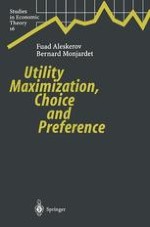2002 | OriginalPaper | Buchkapitel
Utility Maximization Within a Threshold Depending on Both Compared Alternatives
verfasst von : Professor Fuad Aleskerov, Professor Bernard Monjardet
Erschienen in: Utility Maximization, Choice and Preference
Verlag: Springer Berlin Heidelberg
Enthalten in: Professional Book Archive
Aktivieren Sie unsere intelligente Suche, um passende Fachinhalte oder Patente zu finden.
Wählen Sie Textabschnitte aus um mit Künstlicher Intelligenz passenden Patente zu finden. powered by
Markieren Sie Textabschnitte, um KI-gestützt weitere passende Inhalte zu finden. powered by
In this Chapter we consider the utility maximization models within a threshold in which the threshold function depends on both compared alternatives, i.e., has the form ε(x, y). In Section 4.2 it is shown that any pair-dominant function can be rationalized by utility maximization with such a threshold function. Then we formulate sufficient and/or necessary conditions on the function ε(x, y) in order that the corresponding binary relation satisfies acyclicity, transitivity, negative transitivity or the strong intervality condition. In Section 4.3 we study the case when the threshold function ε(x, y) additively depends on the thresholds of the separate alternatives, i.e., ε(x, y) = δ(x) + δ(y). It is shown that the corresponding binary relations are either a biorder or an interval order. In Section 4.4 the case of multiplicative threshold function is considered, i.e., the case when ε(x, y) = δ(x)δ(y). Moreover, we assume that the threshold function δ depends on the utility value of the alternative in a special way: δ(x) = α(x) β , α > 0, β ∈ ℝ. It is shown that in all cases the corresponding binary relation is an interval order. However, when β ∈ [0, 1] a stronger statement can be made, namely, that the corresponding relation is a semiorder.
